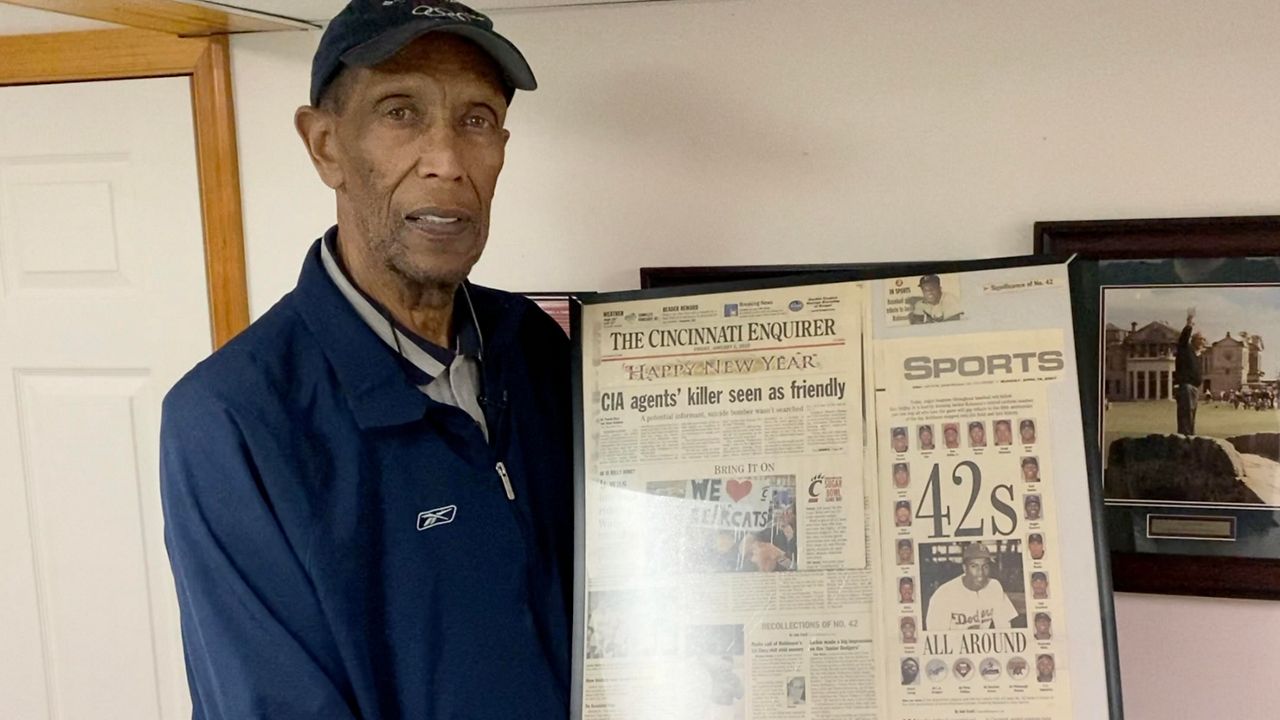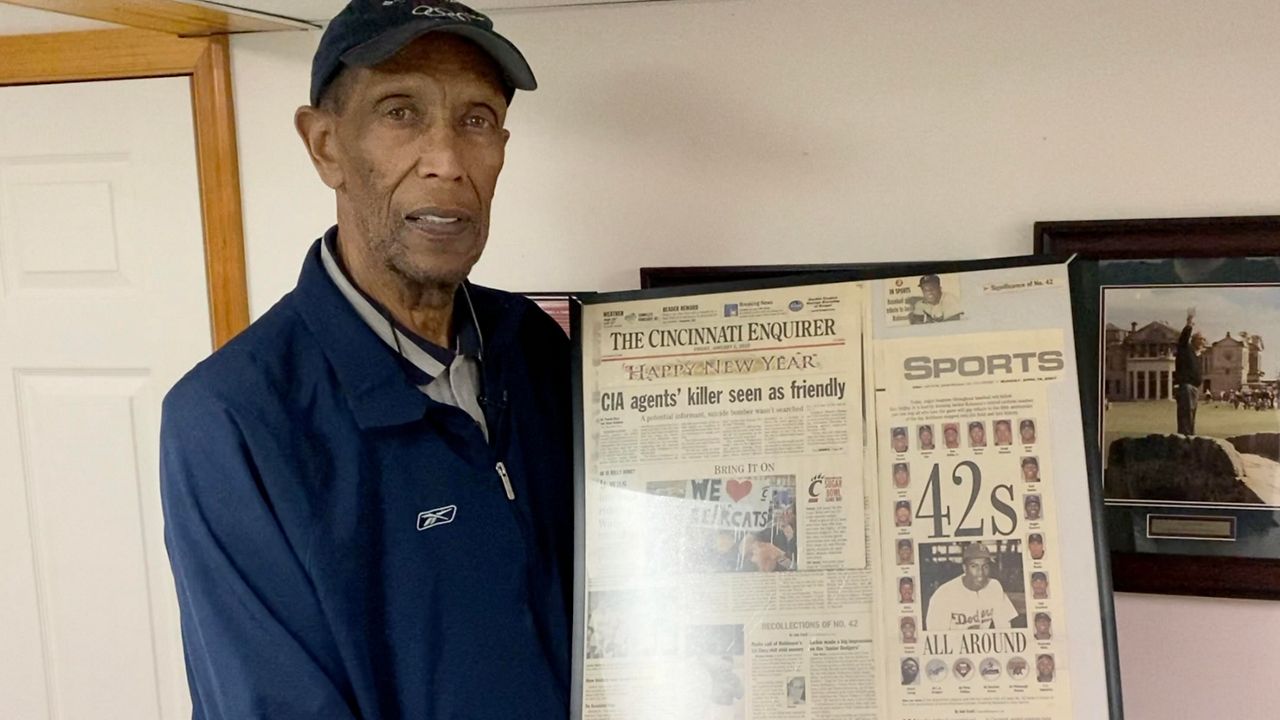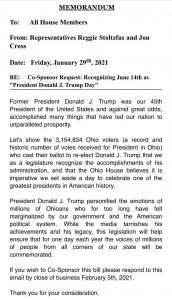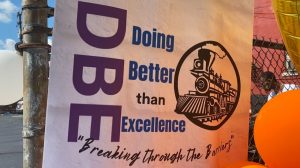COVINGTON, Ky. — April 15, 2022 was the 75th anniversary of Jackie Robinson breaking the color barrier in professional sports in America by becoming the first African American player to play in a Major League Baseball game.
Former NBA player George Wilson explained why the achievement was so monumental, and what it felt like at the time.
“My hero, Jackie,” Wilson said, holding up a framed newspaper clipping of Robinson, part of the museum of sports memorabilia in the basement of his Fairfield, Ohio home. “That inspired me. Because the majority of Americans don’t realize. They want to say it’s not about race. It is about race. I never got to see anybody that looks like me on the football field, or on the basketball team, but once you see them—they’re my heroes.”

Former NBA player George Wilson says he was inspired by Jackie Robinson (Spectrum News 1/Sam Knef)
Wilson, an African American Cincinnati sports legend, was just a little kid when Robinson put on his No. 42 Dodgers uniform and took the field for the first time.
He described what it was like for Robinson, recalling one occasion when Robinson was confronted in the dugout.
“‘I don’t care how many home runs you hit. You’re still a blank-blank-blank.’ And he had to go through that all the time,” Wilson said. “But he still hung in there.”
Hanging in there and being tough are traits Wilson had to adopt in his own playing career.
From the 1950s into the 1970s, Wilson, who eventually grew to be 6’8’’, starred on his Illinois State Champion high school basketball team. His team was the second all-Black team in America, he said, after his other hero, Oscar Robertson’s, all-Black team in Indianapolis.
At the University of Cincinnati, the Bearcats won the NCAA national championship in 1961, though Wilson was a freshman and didn’t play. The team repeated as champions, however, in 1962, with Wilson starring on the team.
He played on the gold medal-winning 1964 USA Olympic basketball team, a lifelong dream of his. Then, Wilson played seven years in the National Basketball Association, which began with a two-year stretch playing with his hero Robertson, known as “The Big O” on the Cincinnati Royals, a team that currently exists as the Sacramento Kings.
Despite Robinson’s achievements happening more than 20 years before Wilson’s playing days were over, “Big George,” as he was called, said he dealt with racism throughout all of them.
One instance came in 1959, after the high school state title game in Illinois. Wilson approached a referee he felt had unfairly called fouls on him during the game, which his team lost.
“I said, ‘Ref, I still don’t know how you called that third foul when I had my hands up like this.’ He looked at me with the nastiest look, one of them I’ve ever seen. He said, ‘Get out of my face, and go play like a good little boy.’ And when he said that, I lost it,” Wilson said.
His team won the state title by 30 points the following year.
In college, there were more instances of discrimination. The 1962 UC team had four Black starters.
“We were the first in the history of NCAA to have that, but they never gave us the credit,” Wilson said. “You couldn’t believe the phone calls [our coach] would get, or the nasty letters.”
Even as a pro, he faced heckling.
“When we’d got to certain other cities, fans used to say stuff and do stuff, but that’s okay, we handled it,” he said. “They’d throw stuff, and use them nasty words. I would say, ‘Look at the scoreboard. Take that.’”
At the Behringer-Crawford Museum in Covington, the “Diverse Diamond,” a collection that tells the stories of athletes who helped advance diversity in baseball throughout its history, gives an insight into Robinson’s ties to Kentucky, and the athletes he inspired.
“Walking into stadiums of people that maybe didn’t like him just because of the color of his skin. And winning their hearts by how skilled he was. And that’s really something,” said Curator of Collections Jason French. “He was a tremendous player. He was so good, and people loved to see him. And he was thick-skinned. It took that to be able to do what he did.”
Robinson’s main connections to the Bluegrass state, French explained, were his relationships with two men: Happy Chandler and Pee Wee Reese.
Chandler served terms as Kentucky’s governor both before and after a stint as Major League Baseball Commissioner during the time Robinson broke through.
Reese, a “tremendous player” in his own right, as French described, was from Louisville, and a close friend of Robinson’s.
French explained how, coming out of the Civil War, baseball was becoming America’s pastime. But not all of America together.
“For a long time, baseball was fairly segregated,” he said.
Before his debut in the major leagues, Robinson played for the Kansas City Monarchs, one of the prominent teams of the Negro Leagues. His transition was a jumping off point for a lot of other Black athletes.
“Because everything changed after that color barrier was broken,” French said.
Branch Rickey is the man who signed Robinson from the Negro Leagues to a major league contract.
Wilson said it was because Robinson could handle the pressure.
“Branch Rickey is the one I always want to clap for. Because he took a chance. Can you imagine the letters and the name calling that he got doing what he did?” Wilson said. “The Negro League could beat every American and National League team back then. There were four or five players in the Negro League better than Jackie, in all phases. But Branch Rickey knew he had to get that one person. Because if Jackie had messed up, you wouldn’t have gotten a Black person in baseball till the 1950s.”
Even though 75 years later, athletes today still have to deal with discrimination, Wilson said he’s grateful to No. 42 for setting the standard on how to rise above it.
French explained why he’s fascinated with Robinson.
“For me, history is about stories. And every experience we have as human beings has stories. And if we learn from each other, and we learn these stories, it teaches us so much about how we’re all very similar,” he said. “I actually don’t see well. Baseball is not something that I can enjoy from sitting down and watching it, because I don’t see what’s going on. But the stories of the individuals, it personalizes it.”
An additional Kentucky connection, French explained, was the first Negro Leagues Museum, which was originally in Ashland, Ky., before moving to Kansas City, Mo.




